Towards the end of 2017, PhD candidate Ruth Cozien and her husband Dr Timo van der Niet were attending a citizen science workshop high up in South Africa’s Drakensberg mountains when they stumbled across “this weird plant with green flowers hidden beneath its leaves, a really strong scent and enough nectar to drown an insect”, Cozien recalls.
While many people might have admired the plant and walked away the couple, both members of the Pollination Ecology Research Group at the University of KwaZulu-Natal, were intrigued.
Most plants have brightly coloured flowers that act as a beacon for would-be pollinators like birds, bees and butterflies. But in this case, with its green flowers well camouflaged and very low to the ground, the couple surmised that the Guthriea capensis (commonly known as “the hidden flower”) must belong to the few species pollinated by small ground-dwelling mammals such as mice and elephant shrews. Despite first being described in 1876, the plant’s ecology had never been studied, so they set out to investigate.
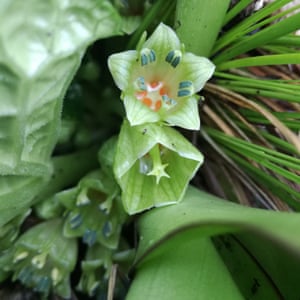
It didn’t take much to persuade Dr Sandy-Lynn Steenhuisen at the University of the Free State’s department of plant sciences and Prof Steven Johnson of the Centre for Functional Biodiversity at KwaZulu-Natal to join the couple on a two-week “working holiday” in the mountains.
Leaving their base at around 6am, the group spent more than 12 hours on the mountain every day, lugging everything from motion-trigger cameras to rodent traps and peanut butter bait balls up and down the steep slopes the Guthriea call home in their quest to work out who was pollinating the flowers. They often left the site in complete darkness, as thick mist swirled around them. “I’ve never been involved in such a physically demanding project,” says Steenhuisen, who frequently found herself lagging behind trail-runners Cozien and Van der Niet.
The plants’ flowers were so low to the ground that simply setting the camera traps was a challenge which involved either digging into the stony ground (“and trying not to accidentally kick a rock on to a hiker below”) or using the very steep terrain to aim the shot “up the plant’s skirt”, says Cozien. They were fairly convinced that the plants were being pollinated by nocturnal rodents, and initially set the cameras to only record at night.
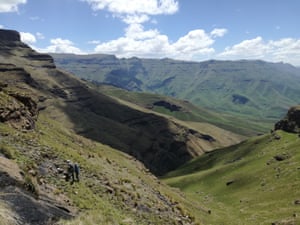
After five frustrating days of getting no closer to finding their pollinator, the team changed tack. They started recording all day and increased the motion-sensitivity settings so that smaller creatures could also trigger the traps.
It paid off. Late one night, while downloading the new data over beers at the lodge, Johnson came across an image of a lizard visiting the flowers. The 26-centimetre Drakensberg crag lizard (Pseudocordylus subviridis) is “super common” in the study area, says Cozien. “But none of us expected lizards to be the pollinators. In fact, we never even considered it.” In the days to follow they got more and more footage of lizards sticking their snouts deep into the flowers to drink the nectar.
Lizard pollination is, according to Cozien, “among the rarest and most poorly understood pollination systems globally”. The first published observation of lizards visiting flowers to feed on nectar was from the Portuguese island of Madeira in 1977, and since then as many as 40 species of geckos and lizards have been observed doing the same.
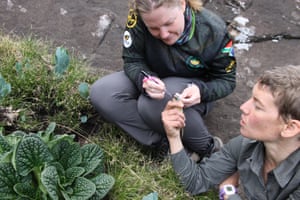
But visiting a flower is very different to pollinating it, Cozien says, “especially because they often eat the flowers!” Lizards have only been shown to be important for pollination of “at most five” species in the world, and only one species of plant was known at the time to use reptiles as its primary pollinator.
Partly because lizard pollination often occurs in harsh, inaccessible or disturbed environments, pollination experts around the world are, Cozien admits, “still trying to work out what floral traits are important for the attraction of lizards, why it evolves where it does, and how important pollination by lizards really is. For all we know, there are loads of other examples.”
After tweaking the camera settings (being cold-blooded, lizards aren’t very good at triggering heat sensors), the team got more footage of the lizards devouring the nectar (which, Cozien says, tastes “absolutely vile” to humans, “like bitter, burnt plastic”) at all times of the day and throughout the flowering season. After catching some of the lizards, the scientists were able to confirm that, thanks to the adhesive properties of the very sticky nectar, the lizards were carrying Guthriea pollen on their smooth, scaly snouts.
By restricting the lizards’ access to some of the plants, they also found that after a few weeks there were 95% fewer fruits on the plants not visited by lizards. Back at the lab, they dusted the anthers of some male flowers with powdered dye and watched as the now pink-cheeked lizards spread the dye (and thus the pollen) on the reproductive parts of the female flowers.
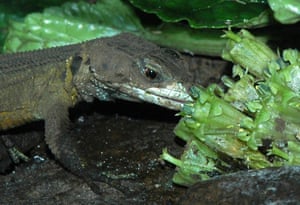
The scientists had discovered only the second known plant to use reptiles as its primary pollinator, and the first to do so on the African continent.
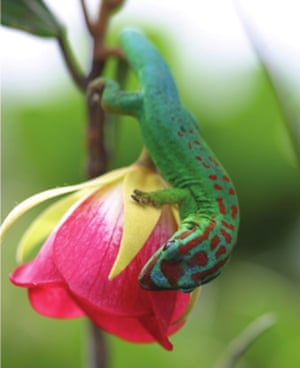
The only other plant that is known to use reptiles as its primary pollinator is Trochetia blackburniana, a three-metre-high tree with bright red flowers on the island of Mauritius which is pollinated by geckos. Cozien says: “It is striking that the red of the Trochetia flowers matches the red markings on the geckos’ bodies, just as the orange glands at the base of Guthriea flowers match the orange markings on the crag lizards’ bodies.” This suggests that the flowers pollinated by lizards may be tuning in to sensory channels that the pollinators already use.
And the similarities between Trochetia and Guthriea don’t end there. Both have cup-shaped flowers that contain yellow-orange coloured nectar. Coloured nectar has already been shown to be important for attracting gecko pollinators to Trochetia flowers, says Cozien, “so we think it plays a similar role in attracting lizards to Guthriea once they have used colour cues to find the flowers under the leaves”.
Confirming the first case of lizard pollination on the African continent was “just a completely mind-blowing experience”, says Cozien. “We thought we were going to document something cool but expected. But then something completely unexpected happened. It’s so exciting to be reminded that there are still things to discover … And often they are right under our noses.”
“It reminded me of why we do what we do,” adds Steenhuisen. “A lot of science is a slog. But moments like this make it all worth while.”
Find more age of extinction coverage here, and follow biodiversity reporters Phoebe Weston and Patrick Greenfield on Twitter for all the latest news and features